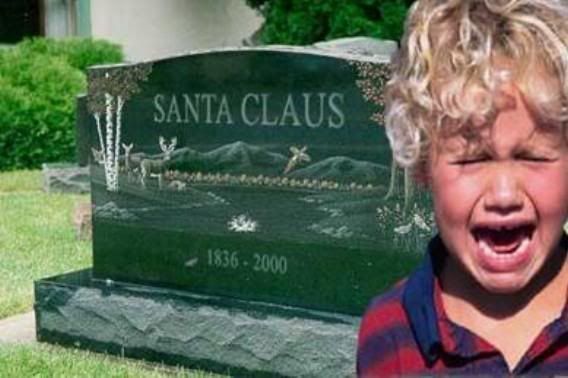subtitle: Christmas-time at our house – part 3
This is the 3rd installment in my Christmas-time at our House series. We do holiday things differently around our house. After all, it IS my house and I’m OK with being weird. Is it any surprise, then, that “Santa” gets special treatment at our house? It’s true. But it might not be quite what you think it is.
What do YOU do with Santa Claus? What do you think about him? Do you think about him at all, or do you just do the Santa thing because it’s what has always been done and everyone around you is doing it? Santa is the fun part of Christmas, right?
 So how do you (we) respect the magnitude of influence that this jolly old elf has on the Christmas season, while still focusing on the REAL reason for the season – Christ’s birth? It’s tough to do both, but it can be done, I think, if you are intentional about how you deal with all the hype, rather than the hype dictating to you what should be done.
So how do you (we) respect the magnitude of influence that this jolly old elf has on the Christmas season, while still focusing on the REAL reason for the season – Christ’s birth? It’s tough to do both, but it can be done, I think, if you are intentional about how you deal with all the hype, rather than the hype dictating to you what should be done.
My husband and I both grew up with Santa as part of Christmas. In different ways for each family, Santa was included to some degree.
My grandfather was a rather rotund fellow with a bit of a beard, and he was always at our house when we woke up on Christmas morning. This lead my sister to believe that Papa must be Santa Claus. We wrote our letters to Santa Claus with the envelope addressed to Santa at our grandparents’ address. My sister told her friends she knew who the real Santa was (I think she was 7 or 8?). She was devastated to find out that Papa wasn’t really Santa Claus. It was pretty awful.
Santa always had a gift for my husband and his sister when they were growing up, usually an unwrapped package that showed up on Christmas morning, and smaller gifts in their stockings, also from Santa. My sweetie doesn’t remember when he found out that Santa wasn’t real. But Santa hadn’t been the real focus for them as a Christian family so it wasn’t that big of a deal for Santa not to be real.
 My sweetie and I had to decide together what OUR Christmases would look like as a family. So, of course, the issue of Santa came up early in our discussions. We didn’t have any real answers or examples of alternatives to look to for guidance. Then we met Martha Zimmerman (I’ve mentioned her in my previous posts), and she DID have some ideas. For her things really get down to the “WHY”. Why do you do what you do, whatever it is? With that in mind, my husband and I tackled the issues of Santa and decided what we wanted to communicate and how to best do that.
My sweetie and I had to decide together what OUR Christmases would look like as a family. So, of course, the issue of Santa came up early in our discussions. We didn’t have any real answers or examples of alternatives to look to for guidance. Then we met Martha Zimmerman (I’ve mentioned her in my previous posts), and she DID have some ideas. For her things really get down to the “WHY”. Why do you do what you do, whatever it is? With that in mind, my husband and I tackled the issues of Santa and decided what we wanted to communicate and how to best do that.
If you know us, you know that truth is very important to us. So, for my sweetie, the issue of Santa really boiled down to truth. He applied his conclusion to most fictional holiday figures. It goes something like this: “I never want to give something to my children that I know I will later have to take back. The whole point is always doing all that we can to tell our children the truth in all things.”
Let me expand on that.
 If we play along and say that _______ (fill in the blank with Santa, The Easter Bunny, the Tooth Fairy, etc.) is real, for a while, and then later say that he isn’t real, there’s likely no great harm done. Some children do have terrible experiences when finding out the truth (e.g., my sister), but for most it’s just a part of growing up, as you say.
If we play along and say that _______ (fill in the blank with Santa, The Easter Bunny, the Tooth Fairy, etc.) is real, for a while, and then later say that he isn’t real, there’s likely no great harm done. Some children do have terrible experiences when finding out the truth (e.g., my sister), but for most it’s just a part of growing up, as you say.
BUT, when a child goes out and about in the world, this world, they can SEE Santas. They can go and touch him and sit on his lap and pour out their hearts’ desires to him. They gather the eggs hidden by the Easter Bunny and they can collect the money left under their pillow by the Tooth Fairy. For children, those things are very real, and they substantiate the existence of these special ‘people’ or creatures. These are tangible, “provable” things. Because Santa answers my letter to him, eats the cookies I set out for him, and leaves gifts for me, I believe he’s real. Santa is in my neighborhood, on my TV, and he seems real enough.
When, as a parent, you let the children in on the secrets of these holiday beings, they can usually ‘connect the dots’ and see the fun in it all. Santa is then set aside – he really isn’t real, but we all just play along for fun anyway.
As a Christian parent, though, I think the implications are far greater than just some fun secrets.
 While Santa is very real in this world (“I saw him at the mall today”), Jesus, on the other hand, is not as easily seen in this world. There are children who do see Jesus with their physical and spiritual eyes, but I am guessing that the majority have only ever seen pictures of what people think Jesus looks like. Jesus has never waved at them in a parade, never cuddled them in his lap, and never audibly whispered “Have you been naughty or nice?” in their little ears. Jesus doesn’t drink the egg nog, leave a basket full of chocolate bunnies, or in any tangible, physical way acknowledge their lost tooth. Jesus is a man in some Sunday School stories about times long ago and places far away.
While Santa is very real in this world (“I saw him at the mall today”), Jesus, on the other hand, is not as easily seen in this world. There are children who do see Jesus with their physical and spiritual eyes, but I am guessing that the majority have only ever seen pictures of what people think Jesus looks like. Jesus has never waved at them in a parade, never cuddled them in his lap, and never audibly whispered “Have you been naughty or nice?” in their little ears. Jesus doesn’t drink the egg nog, leave a basket full of chocolate bunnies, or in any tangible, physical way acknowledge their lost tooth. Jesus is a man in some Sunday School stories about times long ago and places far away.
Yet we assert that Jesus IS real. And, at least when they are young, our children believe us, because we believe. They believe because it is what they are taught to do.
 But at some point we take away some of the key figures in their lives who they thought were real. They had evidence and experience to prove to them that Santa is real. Then we tell the children that Mr. Claus doesn’t live with Mrs. Claus at the North Pole in a workshop full of elves – it was really Grandpa (or some lady on the internet) who wrote the letters, it was really Dad who ate the cookies and drank the egg nog, and it was really Mom who did all the shopping and wrapping. “We’ve all been having a bit of fun, you see.”
But at some point we take away some of the key figures in their lives who they thought were real. They had evidence and experience to prove to them that Santa is real. Then we tell the children that Mr. Claus doesn’t live with Mrs. Claus at the North Pole in a workshop full of elves – it was really Grandpa (or some lady on the internet) who wrote the letters, it was really Dad who ate the cookies and drank the egg nog, and it was really Mom who did all the shopping and wrapping. “We’ve all been having a bit of fun, you see.”
What does that say about Jesus? The children likely have little or no evidence or experience to prove to them that Jesus is alive and real. We have stories, some of which seem as far-fetched as flying reindeer and around-the-whole-world-in-one-night gift delivery trips.
Beyond that, all the children have is our word. But our word isn’t quite as trustworthy as it was before, (is it?) once we’ve revealed the true secrets of our treasured traditions.
 I don’t know that it’s a cognizant thought process, but a seed of doubt is planted in a child’s heart. “How do I know Jesus is real? Santa seemed much more real to begin with than Jesus ever has, and now you tell me Santa isn’t real. When are you going to tell me that Jesus isn’t real either? How old do I have to be before you let me in on THAT secret, too?”
I don’t know that it’s a cognizant thought process, but a seed of doubt is planted in a child’s heart. “How do I know Jesus is real? Santa seemed much more real to begin with than Jesus ever has, and now you tell me Santa isn’t real. When are you going to tell me that Jesus isn’t real either? How old do I have to be before you let me in on THAT secret, too?”
You may think that this is ‘over-the-top’. But this is the kind of foundation of trust (or lack thereof) that we did NOT want to lay with our chidren. To the best of our ability, we want to always tell or children the truth, because truth in the little things ultimately leads to the one and only Truth. (What we do with truths that are too big for our kids at each stage in their life is another topic for discussion altogether.)
Unfortunately, Santa IS still everywhere, right? And all of your children’s friends have a great time going to have their picture taken with Santa, writing their wish lists to Santa, and waking up to the excitement of presents from Santa under the tree on Christmas morning. We can’t just write this guy off and tell our children he isn’t real and do nothing else about it. (I guess we can do that, but I think there is space for teaching here.)
 We really don’t want our children to feel left out of the fun and excitement of the season (it should be a time of great celebration) and we don’t want them to be made fun of for not believing in Santa Claus. I certainly don’t want to be perceived as a ‘fuddy-duddy’, Grinch, Scrooge myself either.
We really don’t want our children to feel left out of the fun and excitement of the season (it should be a time of great celebration) and we don’t want them to be made fun of for not believing in Santa Claus. I certainly don’t want to be perceived as a ‘fuddy-duddy’, Grinch, Scrooge myself either.
So, what is a fun, exciting, appropriate alternative to Santa that can tell the true story while directing us to the true reason for the season – Christ’s birth?
One answer is in my next post – What Do You Do with Santa? (Christmas-time at our House: part 4).
Original Post with Comments – Worth a Look!
(Picture credits – all from PhotoBucket; original artwork linked directly to photobucket user)







This was a very good post. Check out my web page QU5 for additional views concerning about Airport Transfer.